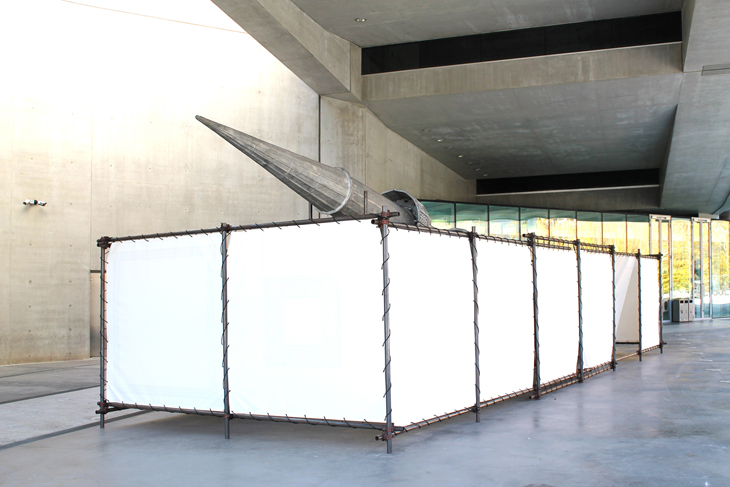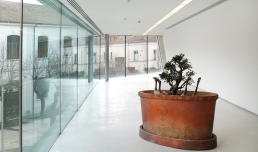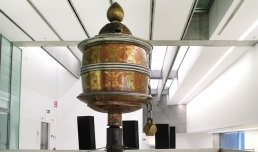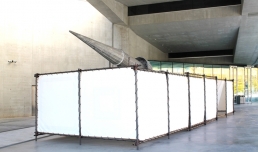Huang Yong Ping. Bâton Serpent
photogallery
MAXXI in the world
RED BRICK ART MUSEUM | Pechino
September 26, 2015 – February 16, 2016
POWER STATION OF ART | Shanghai
March 18 – June 19, 2016

Monday closed
Tuesday to Sunday 11 am – 7 pm
Tuesday 24 December 11 am > 4 pm
Monday 25 December closed
Tuesday 31 December 11 am > 4 pm
Wednesday 1 January 11 am > 7 pm
Monday 6 January 11 am > 8 pm
for young people aged between 18 and 25 (not yet turned 25); for groups of 15 people or more; La Galleria Nazionale, Museo Ebraico di Roma ticket holders; upon presentation of ID card or badge: Accademia Costume & Moda, Accademia Fotografica, Biblioteche di Roma, Centro Sperimentale di Cinematografia, Enel (for badge holder and accompanying person), FAI – Fondo Ambiente Italiano, Feltrinelli, Gruppo FS, IN/ARCH – Istituto Nazionale di Architettura, Sapienza Università di Roma, LAZIOcrea, Palazzo delle Esposizioni, Amici di Palazzo Strozzi, Accademia Nazionale di Santa Cecilia, Scuola Internazionale di Comics, Teatro Olimpico, Teatro dell’Opera di Roma, Teatro di Roma, Università degli Studi di Roma Tor Vergata, Youthcard; upon presenting at the ticket office a Frecciarossa or a Frecciargento ticket to Rome purchased between 27 November 2024 and 20 April 2025
valid for one year from the date of purchase
minors under 18 years of age; disabled people requiring companion; EU Disability Card holders and accompanying person; MiC employees; myMAXXI cardholders; registered journalists with a valid ID card; European Union tour guides and tour guides, licensed (ref. Circular n.20/2016 DG-Museums); 1 teacher for every 10 students; AMACI members; CIMAM – International Committee for Museums and Collections of Modern Art members; ICOM members; journalists (who can prove their business activity); European Union students and university researchers in art history and architecture, public fine arts academies (AFAM registered) students and Temple University Rome Campus students from Tuesday to Friday (excluding holidays); IED – Istituto Europeo di Design professors, NABA – Nuova Accademia di Belle Arti professors, RUFA – Rome University of Fine Arts professors; upon presentation of ID card or badge: Collezione Peggy Guggenheim a Venezia, Castello di Rivoli Museo d’Arte Contemporanea, Sotheby’s Preferred, MEP – Maison Européenne de la Photographie; on your birthday presenting an identity document
MAXXI’s Collection of Art and Architecture represents the founding element of the museum and defines its identity. Since October 2015, it has been on display with different arrangements of works.

Monday closed
Tuesday to Sunday 11 am – 7 pm
Tuesday 24 December 11 am > 4 pm
Monday 25 December closed
Tuesday 31 December 11 am > 4 pm
Wednesday 1 January 11 am > 7 pm
Monday 6 January 11 am > 8 pm
RED BRICK ART MUSEUM | Pechino
September 26, 2015 – February 16, 2016
POWER STATION OF ART | Shanghai
March 18 – June 19, 2016


A fabric barrier prevents viewers from seeing the minaret, conjuring the restoration work under way on the dome of Hagia Sophia (1997-2002), in a reflection on the accessibility of holy sites. The minaret, on the other hand, conveys a dual concept: it reflects on the topic of religion as the only mean to attain the highest realms of heaven, but it is also a satire against some Western preconceptions about the supposedly threatening nature of Islam.

©2015. Nome fotografo
This snkae, about forty metres in length, had been a key figure in Chinese mythology since ancient times: traditionally associated with water, knowledge and wisdom, it is sometimes also a symbol of fear, creation, desire, deception or good luck.
Religious references also appear in La chaise à prière (2010) an upturned chair that bears a biblical story – a passage from the Book of Job – and Camel (2012), a stuffed camel that, on its flank, bears a passage from the Gospel of Matthew while 95 bras de Guanyin(1997-2014), a Duchamp-like bottle rack on which as many human arms are stuck, holding various kinds of objects, makes clear reference to the demand for debate and exchange between different cultures and religions.

It embodies the principle of non-violence, which is inherent in Buddhist spirituality, but it also suggests imminent danger: the trunk that supports the wheel is an image of a “mao”, a Chinese weapon, the lid resembles a shield, and the powerful movement of the wheel conjures up the idea of an ominous dialogue between religion and politics.

HUANG YONG PING - Chefs
Living together means to respect rules based on a hierarchy and a division of labour, focusing on who and what dominance really is. It encourages us to reassess our understanding of our relationships both with others and with the world around us.
The exhibition continues with Bugarach (2012): the work, that reflects on cultural and political power systems, is in the form of a miniature mountain – that of Bugarach in France, a key venue for esoteric tourism. In 2012 it was considered to be the only place where it would be possible to escape the apocalypse foreseen by the Mayan people.

Lamb Plant (2012) is the plant-animal chosen by the artist to address the issue of biopolitics, in order to explore the practices adopted by the powers that be to discipline the body and regulate populations.
The exhibition closes with a compendium work La Carte du Monde (2000-2001), in the form of a travel guide for the future of mankind.









Galleries 1 and 3 and the museum piazza
curated by Hou Hanru and Giulia Ferracci
A challenge to the traditional visual languages of art, ready to express tensions and break down the myths and utopias of contemporary era, for the first time in Italy Huang Yong Ping is showing installations of monumental size, several sculptures and a wealth of documentation to complement the works on display.
“Aaron cast down his staff before Pharaoh and before his servants, and it became a serpent”.
Exodus 7, Bible
The title of an exposition so eschatological refers to the famous Bible passage telling the miracle in which a rod is turned into a serpent. The entire show is designed as an exodus, a migration of power and knowledge, and a process of liberation and emancipation from our conventional social and cultural values.
After founded one of the most important Chinese artistic avant-garde movements, the artist brings into question the rationalist and anthropocentric hegemony of a humanity that has become increasingly detached from its origins.
Bâton Serpent examines include the effects of globalisation, cultural negotiations, migration, neo-colonialism, religious conflicts, economic change, and political fundamentalism.
The artist analyses the contemporary geopolitical situation through a complex and ambivalent dialectic that illustrates the interweaving of historical, cultural and political powers. At the same time it proposes a new force, in the form of dialogue between religions and cultures.
The visionary nature of the works is intensified by interaction with the spaces of the museum and the exhibition consists of three sections, corresponding to three spaces of the museum.
Construction Site
Bâton de Serpent
Ehi Ehi Sina Sina (2006)
Chefs
Lamb Plant
Cataloghi della mostra
Exhibition catalogue
2015
Huang Yong Ping. Bâton Serpent